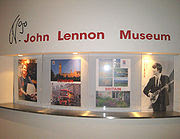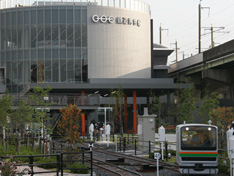Saitama (さいたま市) is the capital and the most populous city of Saitama Prefecture in Japan. Saitama is the capital of Saitama prefecture in the Kanto region of Japan.It dose not have a coast. It merged from four cities few years ago. Therefore it's the biggest city in Saitama. In addition,it's a the tenth most populous city in Japan.
Saitama City was born on May 1, 2001, with the merging of the three cities formerly known as Urawa, Omiya and Yono. On April 1, 2003, it became the 13th government designated city in Japan.
Saitama Prefecture is located right north of Tokyo. This prefecture is part of the Greater Tokyo Area, and most of Saitama's southern area can be described as suburbs of Tokyo. Northern area of the prefecture is dedicated for agriculture. The prefecture is also known for richness of cultural craftsmanship. Hina-doll, Japanese paper, carp streamer, and daruma. Some of the famous spots in this area: Hikawa shrine, Chichibu sanja, Hitsujiyama park, and Seibuen park.
Saitama may be famous for its night festival named "The Chichibu-yomatsuri Night Festival". The former castle town of Kawagoe and the mountainous Chichibu region, known for its night festival held in December, are some of the prefecture's major tourist attractions.
Saitama City is not the tourist city. Therefore, not so many natural scenic to see and to do. But there are several park and museum can be the alternative.
Saitama City, which flourished as a post town on the Nakasendo (Nakasendo Road), a shrine town for the Hikawa Shrine and as a castle town with Iwatsuki Castle, has a variety of historical resources as well as unique cultural resources such as Omiya bonsai, Iwatsuki dolls and Urawa unagi eel. It is furthermore home to the Railway Museum, John Lennon Museum and other distinctive facilities found only in Japan and unique in the world.
Some of Visitor attractions in Saitama City :
1. Akigase Park
2. Besshonuma Park
3. Hikawa Shrine
4. John Lennon Museum. A museum located inside the Saitama Super Arena in Chuo-ku, Saitama City, Saitama, Japan. It was established to preserve knowledge of John Lennon's life and musical career.
5. Minuma
6. Railway Museum. A must of rail buffs and great for kids, the museum features 36 engines on display (including Japan's first steam loco), train cab simulators, Japan's largest HO-gauge miniature railway and more.
7. Sonic City
8. Saitama Stadium 2002, a 2002 FIFA World Cup stadium
9. Saitama Super Arena. A multi-configuration arena that can seat up to 37,000 people. Numerous shops, restaurants and attractions can be found within. A pedestrian walkway links the Saitama Shintoshin train station with the Super Arena.It's very big hall.
10. Omiya Bonsai Village. The Bonsai Village, the bonsai mecca, is also well known overseas
11. Iwatsuki Japanese dolls. Japanese dolls are produced in Iwatsuki, which boasts of the highest volume of doll shipments in Japan
How to access Saitama and around :
Terminal Station: Omiya Station(大宮駅)
Access from Tokyo:
-By Train
0.Shinkansen from Tokyo St. to Omiya St. (25 min.)
1.JR Shonanshinjuku Line from Shinjuku St. to Omiya St. (27 min.)
-By Car
Using Shuto Expressway to Shintoshin (1hr.)

This is the only official John Lennon museum in the world authorized by Yoko Ono.

Kawagoe , 40 km north of Tokyo is an historic castle town noted for its kurazukuri - two-storey wooden merchants' houses some of which have been turned into interesting museums. These historic and pictuesque buildings are conveniently grouped to the north of Kawagoe station.

Musashi Ichi-no-miya Hikawa Shrine, is one of the most superb old shrines of Japan with a history that is said to go back more than 2,000 years and is also the origin of the name Omiya (literally, “large shrine”) as a grand Shinto shrine. As Musashi Ichi-no-miya (which means “top ranking shrine in the Land of Musashi”), it is a center of religious faith in the Kanto area

Saitama Iwatsuki Dolls can fe found at Togyoku Doll Museum. This doll museum developed based on the outstanding Togyoku collection. The collection is diverse and the exhibits include imperial court dolls, hina (Girls’ Festival) dolls, hagoita (battledore) dolls, samurai (Boys’ Festival) dolls, costume dolls,

Saitama celebrates the Chichibu-yomatsuri Night Festival where six floats mounted with a decorative halberd march with lively and soul-stirring Chichibu Yatai-Bayashi music. This is one of the three major float parades in Japan along with the famous Gion-matsuri Festival in Kyoto.

The Omiya Bonsai Village is the general name for the area on the north side of Omiya Park enclosed within the Tobu Noda Line and JR Utsunomiya Line. Known as one of the most outstanding bonsai cultivating areas in Japan, visitors take delight in the bonsai in all seasons as they change from one season to the next.

Based on the concepts of railways, history and education, the museum is comprised primarily of the History Zone, which relates the role and influence of railways in Japan centered primarily in an exhibit of actual railway rolling stock and the Education Zone, where visitors can learn about railway principles and mechanisms as well as the most up-to-date railway technology through hands-on experience while using models, simulation, play equipment, etc.

Skyline of Saitama Shintoshin
Watch Horgalåten at the music festival at Saitama city video here
Meet Japanese Girls here!
Minggu, 03 Januari 2010
Saitama Kanto Region Museum and Night Festival
Diposting oleh
worldchi
di
21.33
0
komentar
![]()
Label: Saitama
Langganan:
Komentar (Atom)









































.jpg)


.jpg)








